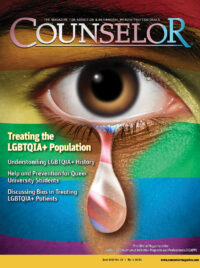Share
Recently, the news continues to report about so-called “religious exemptions” providing services to LGBTQIA+ individuals. Back in 2018 there was a Supreme Court case regarding a bakery that refused to make a wedding cake for a same-gender couple (Gupta, 2018). But now these exemptions are becoming more insidious in nature. For example, a small group of players on the Tampa Bay Rays Major League Baseball team have declined to wear LGBTQIA+ logos on their uniforms for their team’s annual pride event (Jacobs, 2022). A spokesperson for these players stated that the decision is based on “religious beliefs” and not wanting to encourage what he described as LGBTQIA+ “behavior” (Jacobs, 2022).
Based on religious beliefs or not, this is simply bias. Humans practice two forms of bias: explicit and implicit. The Rays players, stating their religious beliefs prevent them from wearing a symbol that affirms and commemorates a group of people who have been historically marginalized, stigmatized, and oppressed, are exhibiting nothing less than explicit bias towards that population. In the article, the team’s spokesperson goes on to say, “It’s not judgmental. It’s not looking down [on LGBTQIA+ individuals]” (Jacobs, 2022).
Explicit bias occurs when people are aware of their prejudices and attitudes toward certain groups or other individuals. For example, someone who drives two more miles for a Starbucks coffee, passing other coffee shops, has an explicit bias toward Starbucks coffee. Implicit bias, on the other hand, occurs when people are unaware of their prejudices and attitudes toward certain groups or other individuals. An example of this is when someone who proclaims to be an ally to the transgender community, especially in hiring practices, still only hires cisgender individuals. They do not realize the cognitive dissonance in their own beliefs and behavior.
Implicit bias is the unconscious preference or judgement made about people based on their characteristics. Usually these are (but are not exclusive to) race, gender, age, and sexual orientation. Members of the LGBTQIA+ community receiving explicit or implicit bias messages clearly have an impact conveying a message of rejection. The language accompanying the “rejection” message then creates a dissonance in the message receiver, which happens more often today to many LGBTQIA+ individuals seeking health care services for addiction treatment.
As more states’ licensing agencies implement requirements for implicit bias training, health care providers should begin to embrace and accept the concept that we are all biased. Annie Murphy Paul, in her article “Where bias begins: The truth about stereotypes,” writes that “By age five, many children have definite and entrenched stereotypes about blacks, women, and other social groups” (1998). What begins to happen around age five, according to the author, is that we begin to formulate our own stereotypes or “implicit stereotypes,” especially about these specific groups. The article acknowledges that explicit bigotry may be on the decline, the author states “stereotyping is a bigger problem than we ever imagined” (Paul, 2016). Unfortunately, LGBTQIA+ bias was not even considered a subject to be studied in 1998 in regard to stereotyping.
It has become an ugly but proven fact that we all stereotype others without knowing it (Stossel & Kendall, 2006; Paul, 1998). It is how the brain breaks down and stores information. Some studies suggest that stereotypes may emerge from what social psychologists call “in-group/out-group dynamics,” or “us versus them” (Paul, 1998). Humans need to feel that they are part of a group, and as villages, clans, and other traditional groupings have broken down, our identities have attached themselves to more ambiguous classifications such as race and class. We want to feel good about the group we belong to, and one way of doing so is to denigrate all those who are not in it (Paul, 1998).
Once health care providers of addiction treatment accept that we are all inherently biased, we can begin dismantling our own divergent biases and racial isolation biases. According to Beeghly and Madva (2020), divergence occurs when our unconscious mental states differ (i.e., diverge) from our consciously held mental state. Let us go back to the previous example of proclaiming to be an ally to the transgender community while only hiring cisgender individuals: this illustrates how significantly the conscious and unconscious minds diverge, and a more reflexive response takes over.
To understand racial isolation, Beeghly and Madva use the example of individuals raised in an all-white town. These individuals only interact with other white individuals growing up, becoming “racially isolated” from others who do not look like them. Once these individuals meet someone who do not look like them, they “automatically” revert to unconscious stereotypes that characterize the non-white person.
To be clear, this is not suggesting that all health care providers today are explicitly biased towards members of the LGBTQIA+ community. However, today more than ever, our LGBTQIA+ clients need acceptance and empathy instead of tolerance and exclusion. Tolerance here implies people’s interactions are only “for the moment” and that they will continue to hold biases and prejudices after the interaction is completed. Health care providers can intentionally be more self-aware of their implicit bias, which may be reflected in nonverbal behavior, in order to mitigate negative and invalidating messages. The impact of implicit bias from health care providers may be characterized by expressions, stances, how far away they stand, and/or how much eye contact they make (Paul, 1998).
By increasing our awareness of our implicit biases, addiction treatment providers can intentionally move away from acting on stereotypes and be more inclusive and professional in providing services. LGBTQIA+ individuals struggling with addiction have already faced discrimination, religious exceptions, and prejudice prior to seeking services. In addition, when the most current research is not inclusive of racial/ethnic, gender, or sexual orientation diversity, health care providers might make the mistake of assuming health disparities do not affect the LGBTQIA+ population. More research is needed to determine the effects of adverse childhood experiences (ACEs; Felitti et al., 1998) on LGBTQIA+ children and the complex posttraumatic stress disorder (C-PTSD) symptoms these children can expect to manifest as adults. The ACEs study has proven that untreated complex trauma can impact individuals’ overall mental health (Felitti et al., 1998), though of course more studies need to be done that include explicit and implicit bias as well as verbal and nonverbal micro aggressions.
More studies are also needed to understand how much society has changed and if addiction treatment has stayed in step with this change. Already this year, the National Association of Social Workers (NASW) has officially adopted and changed its culturally competent ethics to embrace cultural humility concepts (NASW, 2021). When providing services to individuals from the LGBTQIA+ population, cultural competency is insufficient; health care providers need to have a deeper understanding of the effects of implicit bias and untreated complex trauma on LGBTQIA+ children.
One tool immediately available to address implicit bias in providing addiction services to LGBTQIA+ individuals is the Substance Abuse and Mental Health Services Administration’s “Tip 57: Trauma-Informed Care in Behavioral Health Services” (2014). For example, principle eleven states, “view trauma through a sociocultural lens,” and principle sixteen states, “provide hope: recovery is possible” (SAMHSA, 2014).
Other basic concepts to continue using in order to guard against bias are professionalism, decorum, and respecting the dignity of clients. In addition, moving away from the concepts of tolerance and diversity and being more aware of privilege and power-differentials in the therapeutic alliance are equally important. As health care providers, we must surpass tolerance and begin acknowledging inclusivity by actively embracing each client’s full authenticity.
Today, more than ever, clients who do not look like their health care providers need more empathy and empowerment in order to heal and find a path to recovery. Many health care providers today suffer from burnout and are weary from combating COVID-19 with all the havoc the pandemic has caused over the past two years (Levine, 2021). Multiply this by one thousand for your minority and stigmatized clients.
SAMHSA’s TIP 57 states, “more than half of individuals who seek substance abuse treatment report one or more lifetime traumas, and a significant number of clients in inpatient treatment also have subclinical traumatic stress symptoms or post-traumatic stress disorder” (SAMHSA, 2014). Many LGBTQIA+ individuals have also endured childhoods of explicit and implicit bias towards them, preventing them from accepting their authentic selves (APA, 2008). This is why hope can be such a powerful concept for these clients as they seek addiction treatment services. When health care providers begin to validate and forge cultural bridges to their clients, they are building trust and rapport while also allowing the therapeutic alliance to prosper and flourish.
Hope can be a powerful tool to overcome a lifetime of despair and minority stress for most LGBTQIA+ individuals struggling with addiction issues. TIP 57 explains that hope involves “projecting an attitude that recovery is possible, and this also involves viewing clients as competent to make changes that will allow them to normalize discomfort or difficult emotions” (SAMHSA, 2014).
In conclusion, health care providers have concrete data to accept and embrace that we are all biased, both explicitly and implicitly. If left unchecked, these biases can affect the health and well-being of our clients. While we may be unaware of our own implicit stereotyping, more training can assist us in becoming more empowered to practice the concepts and tools discussed in this article. Our vocational call to action is this: reduce bias so we provide the best possible care to our clients.
References
- American Psychological Association (APA). (2008). Sexual orientation & homosexuality. Retrieved from https://www.apa.org/topics/lgbtq/orientation
- Beeghly, E., & Madva, A. (2020). An introduction to implicit bias, knowledge, justice, and the social mind. New York, NY: Routledge.
- Felitti, V. J., Anda, R. F., Nordenberg, D., Williamson, D. F., Spitz, A. M., Edwards, V., Koss, M. P., & Marks, J. S. (1998). Relationship of childhood abuse and household dysfunction to many of the leading causes of death in adults: The adverse childhood experiences (ACE) study. American Journal of Preventative Medicine, 14(4), 245–58.
- Gupta, V. (2018). Gay wedding cake ruling reaffirms that businesses can’t discriminate. Retrieved from https://www.cnn.com/2018/06/05/opinions/masterpiece-cakeshop-supreme-court-opinion-gupta/index.html
- Jacobs, E. (2022). Tampa Bay Rays players decline to wear LGBT logos on uniform for pride event. Retrieved from https://www.washingtonexaminer.com/news/tampa-bay-rays-players-decline-to-wear-lgbtq-logos-on-uniform-for-pride-event
- Levine, D. (2021). US faces crisis of burned-out health care workers. Retrieved from https://www.usnews.com/news/health-news/articles/2021-11-15/us-faces-crisis-of-burned-out-health-care-workers
- National Association of Social Workers (NSAW). (2021). Revised NASW code of ethics now in effect: New self-care, cultural humility/competency provisions added. Retrieved from https://www.naswva.org/post/2021-revised-nasw-code-of-ethics-now-in-effect-new-self-care-cultural-humility-competency
- Paul, A. M. (1998). Where bias begins: The truth about stereotypes: Stereotyping is not limited to those who are biased (last reviewed on June 9, 2016). Retrieved from https://www.psychologytoday.com/us/articles/199805/where-bias-begins-the-truth-about-stereotypes
- Reynolds, D. (2020). Texas social workers can now refuse services to LGBTQ+ clients. Retrieved from https://www.advocate.com/politics/2020/10/16/texas-social-workers-can-now-refuse-services-lgbtq-clients
- Stossel, J., & Kendall, K. (2006). The psychology of stereotypes. Retrieved from https://abcnews.go.com/2020/story?id=2442521&page=1
- Substance Abuse and Mental Health Services Administration (SAMHSA). (2014). Trauma-informed care in behavioral health services: TIP 57. Retrieved from https://store.samhsa.gov/sites/default/files/d7/priv/sma14-4816.pdf

Mark McMillan, LMSW, CAADC
Mark McMillan, LMSW, CAADC, is in private practice at the Center for Relationships and Sexual Health (CRSH) located in Royal Oak, Michigan. He specializes in diverse populations struggling with issues involving recovery, chemical and behavioral addiction, sexual health, and sexual dysfunction. McMillan also serves as vice president to the national board of directors for the National Association of Lesbian, Gay, Bisexual, Transgender Addiction Professionals and Their Allies (NALGAP).









 Counselor Magazine is the official publication of the California Association of Addiction Programs and Professionals (CCAPP). Counselor offers online continuing education, article archives, subscription deals, and article submission guidelines. It has been serving the addiction field for more than thirty years.
Counselor Magazine is the official publication of the California Association of Addiction Programs and Professionals (CCAPP). Counselor offers online continuing education, article archives, subscription deals, and article submission guidelines. It has been serving the addiction field for more than thirty years.